

Johns Hopkins University (JHU) continues to pad its space community résumé with their interactive map, “The map of the observable Universe”, that takes viewers on a 13.7-billion-year-old tour of the cosmos from the present to the moments after the Big Bang. While JHU is responsible for creating the site, additional contributions were made by NASA, the European Space Agency, the National Science Foundation, and the Sloan Foundation.
<>
The SPHERE instrument on ESO’s Very Large Telescope has captured the first ever image of a young, Sun-like star accompanied by two giant exoplanets, located about 300 light-years away from Earth. This animation shows the orbits of the two exoplanets, compared with the size of Pluto’s orbit. Credit: ESO/L.Calçada/spaceengine.org More information and download options:
<>
The SPHERE instrument on ESO’s Very Large Telescope has captured the first ever image of a young, Sun-like star accompanied by two giant exoplanets, located about 300 light-years away from Earth. This video takes us on a journey to this system. Credit: ESO/L.Calçada/spaceengine.org More information and download options:

We’ve detected thousands of exoplanets, but for the most part, nobody’s ever seen them. They’re really just data, and graphs of light curves. The exoplanet images you see here at Universe Today and other space websites are the creations of very skilled illustrators, equal parts data and creative license. But that’s starting to change. The European Southern Observatory’s Very Large Telescope (VLT) has captured images of two exoplanets orbiting a young, Sun-like star. These images are part of a study titled “Two Directly Imaged, Wide-orbit Giant Planets around the Young, Solar Analog TYC 8998-760-1.” Lead author is Alexander Bohn, a PhD student at Leiden University in the Netherlands. The research is published in The Astrophysical Journal Letters.
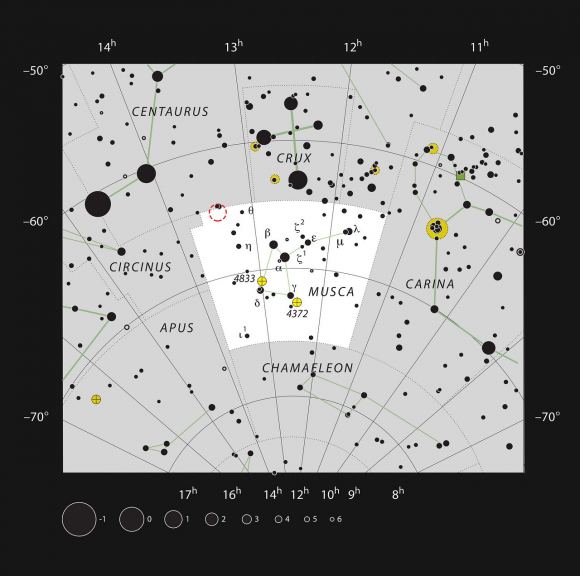
This chart shows the location of the TYC 8998-760-1 system. This map shows most of the stars visible to the unaided eye under good conditions and the system itself is marked with a red circle. Image Credit: ESO
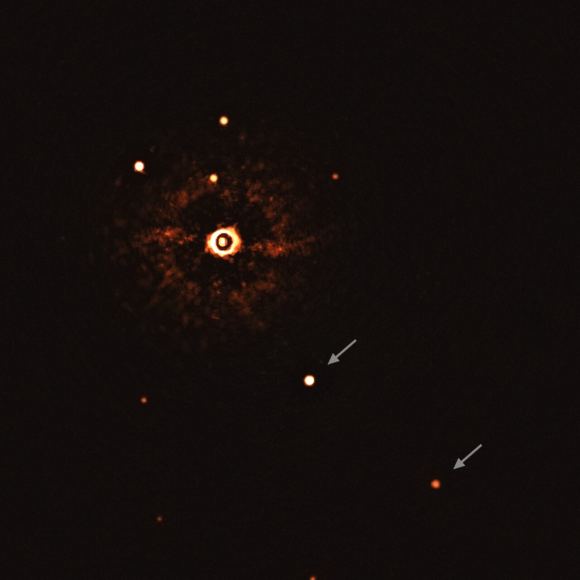
This image, captured by the SPHERE instrument on ESO’s Very Large Telescope, shows the star TYC 8998-760-1 accompanied by two giant exoplanets, TYC 8998-760-1b and TYC 8998-760-1c. This is the first time astronomers have directly observed more than one planet orbiting a star similar to the Sun. Image Credit: ESO/Bohn et al, 2020.
The SPHERE instrument on ESO’s Very Large Telescope has captured the first ever image of a young, Sun-like star accompanied by two giant exoplanets, located about 300 light-years away from Earth. This animation shows the orbits of the two exoplanets, compared with the size of Pluto’s orbit. Credit: More information and download options:
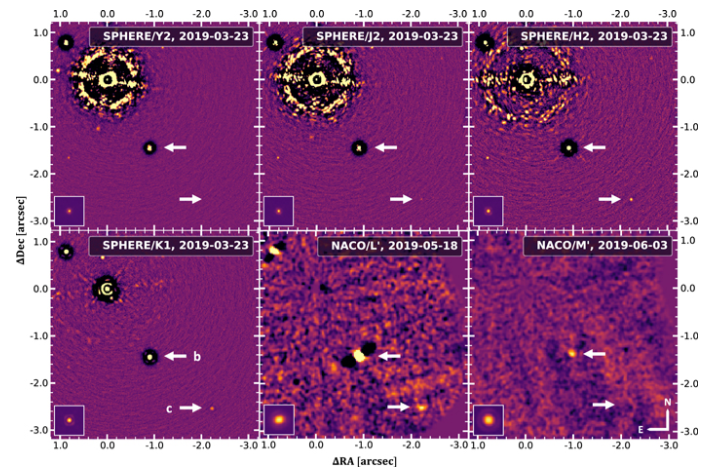
This figure from the study shows the young, Sun-like star and its two exoplanet companions. Though not as compelling as some artist’s illustrations, which are designed to capture the imagination, images like these are data-rich. Each of the six panels are images of the star and its planets with different data reductions applied. In the lower left of each image, inside its own box, is the noncoronagraphic flux PSF (Point Spread Function), that tells astronomers about the filtering used. It’s kind of complicated for non-scientists, which is why professional illustrators are often used to help people understand discoveries like these. Image Credit: Bohn et al, 2020.
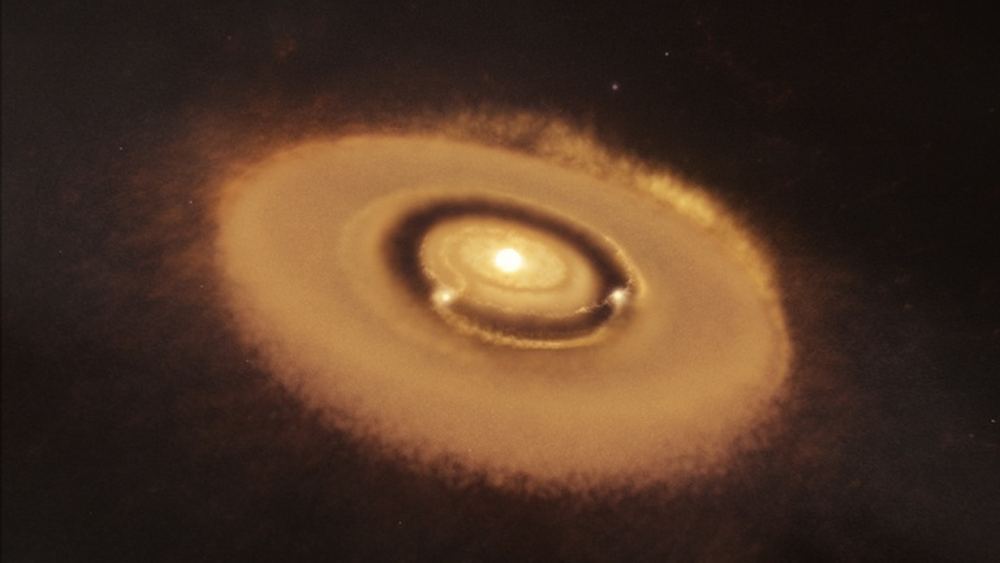
Planet formation is a notoriously difficult thing to observe. Nascent planets are ensconced inside dusty wombs that resist our best observation efforts. But recently, astronomers have made progress in imaging these planetary newborns. A new study presents the first-ever direct images of twin baby planets forming around their star.
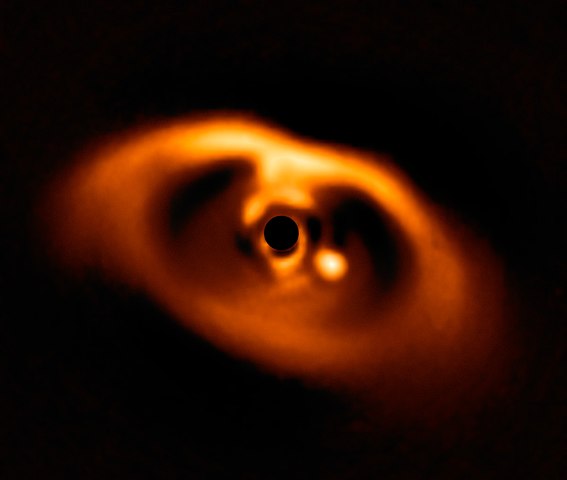
The image of PDS 70b from 2018. It’s from the SPHERE instrument on the VLT. The planet is the bright point to the right of center. The star in the center is blacked out by the coronographs. Image Credit: By ESO/A. Müller et al., CC BY 4.0,

A direct image of PDS 70 protoplanets B and C (labeled with white arrows) with the cicrumstellar disk removed. The image was captured using the W. M. KECK Observatory’s recently upgraded adaptive optics system. Image Credit: J. Wang, Caltech
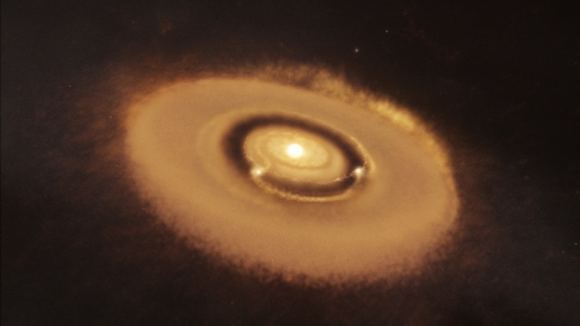
Artist’s impression of the PDS 70 system. The two planets are seen clearing a gap in the protoplanetary disk from which they were born. The planets are heated by infalling material that they are actively accreting, and are glowing red. Note that the planets and star are not to scale and would be much smaller in size compared to their relative separations. Image Credit: W. M. Keck Observatory/Adam Makarenko
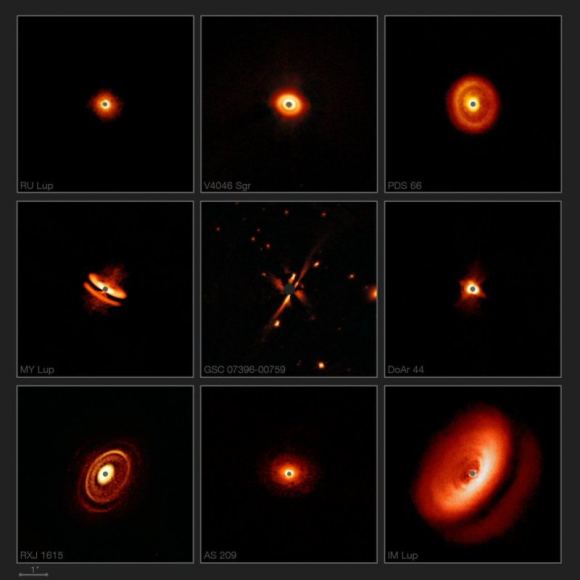
Observing technology is getting stronger and stronger, and we’re getting better at peering into the circumstellar disks around young stars, where planets form. The SPHERE instrument on the ESO’s Very Large Telescope has captured a collection of images of the disks around young stars. The detail in the images is greater than any previous images, and reveals a stunning variety of shapes and sizes. Inside all of these disks, planets like PDS 70b and 70c are likely forming. Image: ESO/H. Avenhaus et al./E. Sissa et al./DARTT-S and SHINE collaborations
For the first time ever, astronomers have captured a direct image of a newly forming planet orbiting around a newly forming star. It’s a stunning photograph, not only for the science and what was observed, but what it means the future of exoplanetary astronomy. Audio Podcast version: ITunes: RSS: Video Podcast version: ITunes: RSS: What Fraser's Watching Playlist: Weekly email newsletter: Support us at:Support us at: Follow us on Tumblr: : More stories at Follow us on Twitter: @universetoday Like us on Facebook: Instagram - Team: Fraser Cain - @fcain / frasercain@gmail.com /Karla Thompson - @karlaii Chad Weber - Chloe Cain - Instagram: @chloegwen2001 References: First Confirmed Image of Newborn Planet Caught with ESO’s VLT Subaru Telescope Discovery of a Giant Gap in the Disk of a Sun-like Star May Indicate Multiple Planets SPHERE reveals earliest stage of planetary nebula formation Mysterious Ripples Found Racing Through Planet-forming Disc Unique structures spotted around nearby star Sculpting Solar Systems ESO’s SPHERE instrument reveals protoplanetary discs being shaped by newborn planets a list of bibliographic references for SPHERE and its various sub-systems. Please cite the publications relevant to your observations.SPHERE: SPHERE Spectro-Polarimetric High-contrast Exoplanet REsearch instrument
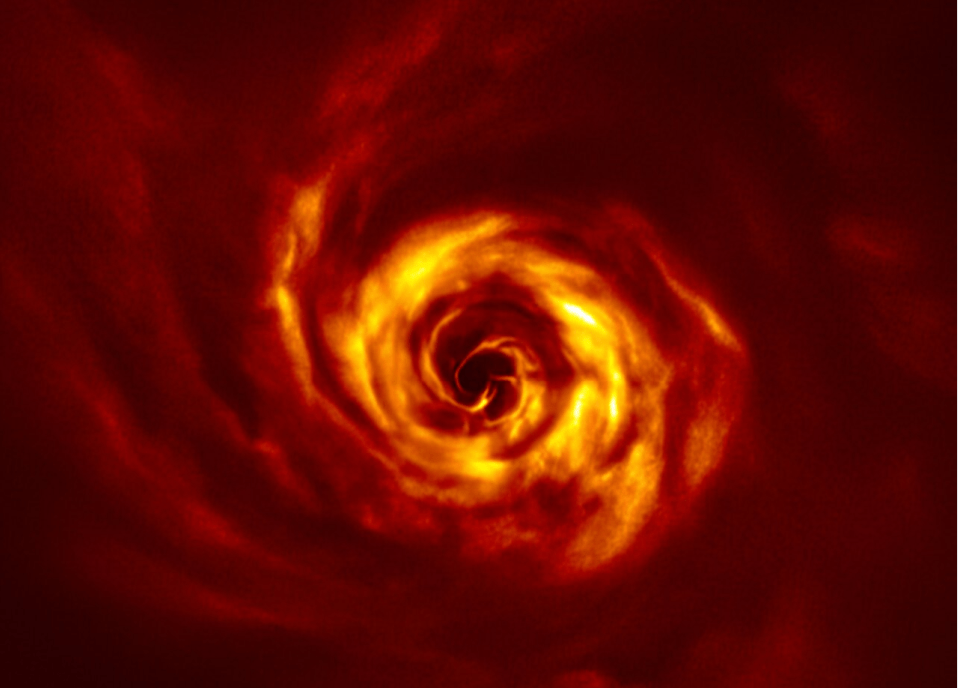
In 2017, astronomers used ALMA (Atacama Large Millimeter/sub-millimeter Array) to look at the star AB Aurigae. It’s a type of young star called a Herbig Ae star, and it’s less then 10 million years old. At that time, they found a dusty protoplanetary disk there, with tell-tale gaps indicating spiral arms.
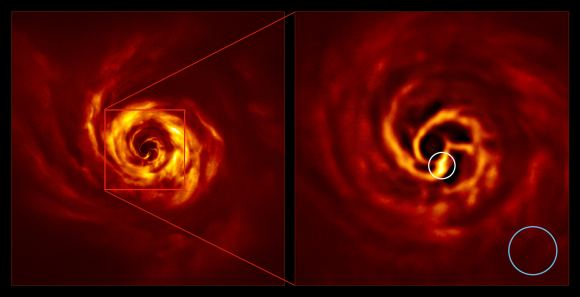
The images of the AB Aurigae system showing the disc around it. The image on the right is a zoomed-in version of the area indicated by a red square on the image on the left. It shows the inner region of the disc, including the very-bright-yellow ‘twist’ (circled in white) that scientists believe marks the spot where a planet is forming. This twist lies at about the same distance from the AB Aurigae star as Neptune from the Sun. The blue circle represents the size of the orbit of Neptune. The images were obtained with the SPHERE instrument on ESO’s Very Large Telescope in polarised light. Image Credit: ESO/Boccaletti et al, 2020
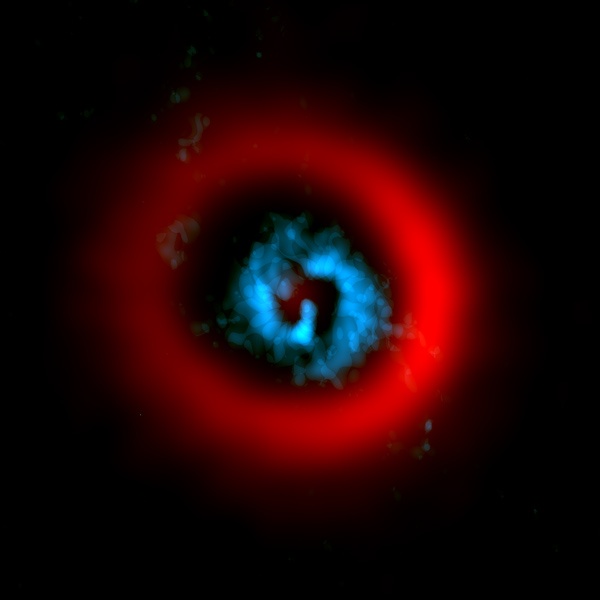
COLOR="RED">ALMA image of the dust ring (red) COLOR="BLUE"> and gaseous spirals (blue) of the circumstellar disk AB Aurigae reveal gaseous spiral arms inside a wide dust gap, providing a hint of planet formation. By ALMA (ESO/NAOJ/NRAO)/Tang et al. – CC BY 4.0,
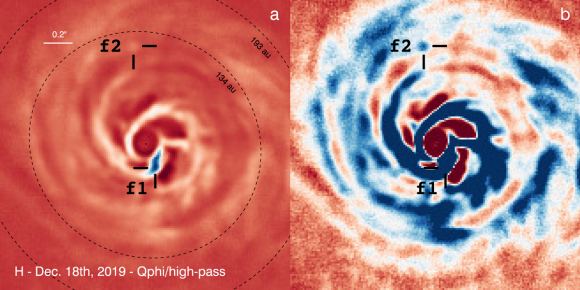
The disk is an elaborate structure, and astronomers observed many other structures within it. Two of them were of particular interest, marked f1 and f2 in this image. Both of these are SPHERE images, each one with a different intensity threshold. Image Credit: Boccaletti et al, 2020.
The Solar System is 4.5 billion years old, but the Universe is much older. What was here before our Solar System formed? Support us at: More stories at: Follow us on Twitter: @universetoday Follow us on Tumblr: Like us on Facebook: Google+ - Instagram - Team: Fraser Cain - @fcain Jason Harmer - @jasoncharmer Susie Murph - @susiemmurph Brian Koberlein - @briankoberlein Chad Weber - weber.chad@gmail.com Kevin Gill - @kevinmgill Created by: Fraser Cain and Jason Harmer Edited by: Chad Weber Music: Left Spine Down - “X-Ray”
Jason J. Wang (王劲飞), 1, ∗ Sivan Ginzburg,2, ∗ Bin Ren (任彬), 1 Nicole Wallack, 3 Peter Gao, 2, ∗ Dimitri Mawet, 1, 4 Charlotte Z. Bond,5, 6 Sylvain Cetre,6 Peter Wizinowich,6 Robert J. De Rosa, 7 Garreth Ruane, 4 Michael C. Liu, 5 Olivier Absil,8 Carlos Alvarez,6 Christoph Baranec, 9 Elodie Choquet ´ , 10 Mark Chun,9 Denis Defr`ere,8 Jacques-Robert Delorme,1 Gaspard Duchˆene, 2, 11 Pontus Forsberg,12 Andrea Ghez, 13 Olivier Guyon, 14, 15, 16 Donald N. B. Hall,9 Elsa Huby,17 A¨ıssa Jolivet,8 Rebecca Jensen-Clem, 18 Nemanja Jovanovic, 1 Mikael Karlsson,12 Scott Lilley,6 Keith Matthews,1 Fran¸cois M´enard, 11 Tiffany Meshkat, 19 Maxwell Millar-Blanchaer, 1, 4 Henry Ngo, 20 Gilles Orban de Xivry,8 Christophe Pinte, 21, 11 Sam Ragland,6 Eugene Serabyn,4 Ernesto Vargas Catal´an,12 Ji Wang, 22 Ed Wetherell,6 Jonathan P. Williams, 5 Marie Ygouf, 23 and Ben Zuckerman13 1Department of Astronomy, California Institute of Technology, Pasadena, CA 91125, USA 2Department of Astronomy, University of California at Berkeley, CA 94720, USA 3Division of Geological & Planetary Sciences, California Institute of Technology, Pasadena, CA 91125, USA 4Jet Propulsion Laboratory, California Institute of Technology, 4800 Oak Grove Dr.,Pasadena, CA 91109, USA 5 Institute for Astronomy, University of Hawaii, 2680 Woodlawn Drive, Honolulu, HI 96822, USA 6W. M. Keck Observatory, 65-1120 Mamalahoa Hwy, Kamuela, HI, USA 7European Southern Observatory, Alonso de Cordova 3107, Vitacura, Santiago, Chile 8Space sciences, Technologies & Astrophysics Research (STAR) Institute, University of Li`ege, Li`ege, Belgium 9 Institute for Astronomy, University of Hawai‘i at M¯anoa, 640 North A‘ohoku Place, Hilo, HI 96720-2700, USA 10Aix Marseille Univ, CNRS, CNES, LAM, Marseille, France 11Universit´e Grenoble-Alpes, CNRS Institut de Plan´etologie et d’Astrophysique (IPAG), F-38000 Grenoble, France 12Department of Materials Science and Engineering, ˚Angstr¨om Laboratory, Uppsala University, Box 534, 751 21, Uppsala, Sweden 13Department of Physics & Astronomy, 430 Portola Plaza, University of California, Los Angeles, CA 90095, USA 14Subaru Telescope, National Astronomical Observatory of Japan, 650 North Aohoku Place, Hilo, HI 96720, USA 15Steward Observatory, University of Arizona, Tucson, AZ 85721, USA 16Astrobiology Center of NINS, 2-21-1 Osawa, Mitaka, Tokyo 181-8588, Japan 17LESIA, Observatoire de Paris, Universit´e PSL, CNRS, Sorbonne Universit´e, Universit´e de Paris, 5 place Jules Janssen, 92195 Meudon, France 18Department of Astronomy & Astrophysics, University of California, Santa Cruz, CA95064, USA 19IPAC, California Institute of Technology, M/C 100-22, 1200 East California Boulevard, Pasadena, CA 91125, USA 20NRC Herzberg Astronomy and Astrophysics, 5071 West Saanich Road, Victoria, British Columbia, Canada 21Monash Centre for Astrophysics (MoCA) and School of Physics and Astronomy, Monash University, Clayton Vic 3800, Australia 22Department of Astronomy, The Ohio State University,100 W 18th Ave, Columbus, OH